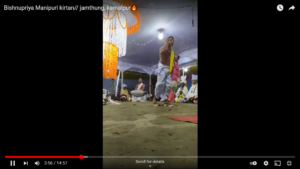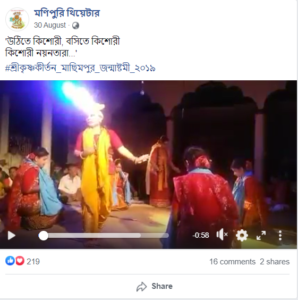
Manipur Univisited
In 1955, when Arnold Bake, now a professor at the School of Oriental and African Studies (SOAS), London, was planning his trip to India after a gap of a decade, which would be his last trip, he had strong desire to go to Manipur to listen to their kirtan. He knew that students from Manipur used to come to Mainadal to their tol or residential school and learn kirtan from the Mitra Thakurs. He wanted to know more. Unfortunately, during his 1955-56 study tour, he could not include Manipur in his itinerary.
What kirtan would Arnold Bake have heard if he went to Manipur in the mid-1950s? What has become of that song now? I have tried in my work to ask these questions and listen for those ‘absent’ sounds. Absent because they are absent from the oeuvre of Arnold Bake.
This sub-chapter is written as a bilingual script, with extracts from emails and Messenger messages which I exchanged with two sets of young Manipuri singers from India and Bangladesh respectively, from around May to December 2021. The conversation continues. I must say that I have barely started to scratch the surface of things and there is so much left to listen to and to understand. However, the questions I posed to my young Manipuri friends have got them thinking too, thus making them part of this search/research.
Correspondence with Akhu
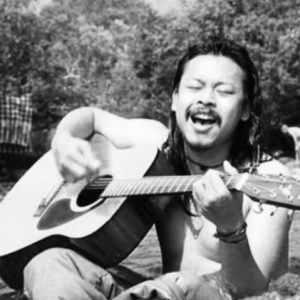
Akhu or Ronid Chingambam, of the band Imphal Talkies and The Howlers has researched folk music and memory in the Manipuri diaspora, besides being a prolific singer and songwriter from the northeast of India, whose songs are sharp and critical of the state and its power, and deeply committed to resistance.
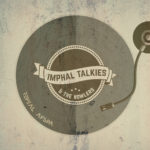 Imphal Talkies’ Youtube channel
Imphal Talkies’ Youtube channel
Moushumi to Akhu (12 May 2021)
I am thinking of how kirtan was practised in Manipur in the first half of the twentieth century. Yesterday I just chanced upon an essay from which I understand that Bengali texts are no longer sung but would you be able to tell me what texts used to be sung in the past … are there any old recordings of Manipuri kirtan that you are aware of?
I have heard from a friend in Sylhet that he remembers Manipuris coming to kirtan singing sessions and singing songs of Jnanadas and other composers, but the style would be very different. … As a lay person, I hear echoes of South East Asian music in the singing, the vocal style reminds me of Chinese music, but I might be wrong. You will know these things and I shall be grateful to learn from you. Are there writings on your kirtan talas?
I am asking all these questions because I know that students from Manipur used to go to Mainadal, a centre of kirtan in Birbhum, for lessons in the early twentieth century. Mainadal is associated with the Manoharsahi style of kirtan and when I read this article, I thought of these connections.
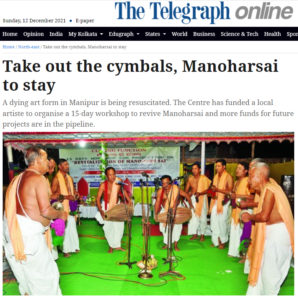
Moushumi to Akhu (13 May 2021)
I am thinking, even though Bake did not get a chance to listen to kirtan in Manipur in 1956, the music did exist. What became of that music over the next six decades, given the revivalist movements, the reclaiming of pre-Vaishnava practices and the rejection of Bangla? If I were to go now, what would I find? What of the past will I be able to find? What is lost? What is new?
Akhu to Moushumi (12 May 2021)
I am not an expert on the subject of Nat Sankirtan but this form of music has been part of Meitei communities for ages.
Our birth/death/wedding ceremonies and rituals are incomplete without this form of music. I think it is a very recent transition from bangla to meiteilon regarding the Sankirtan. Of course it came to Manipur post the vaishnavism invasion and it evolved to become our own form of music. One of the pioneers in the field is Oja Lakhpati, i think he can still sing Nat Sankirtan in Bangla. but they are no longer sung in rituals as there is a movement of revivalism.
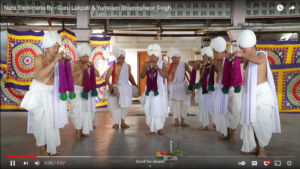
Nata Sankirtana By – Guru Lakpati & Yumnam Bhumeshwor Singh
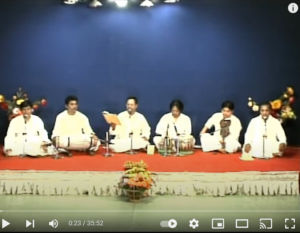
Mana Shikhya/Guru Lakpati/Lyrics: Late Guru Khangenbam Gullapi Singh
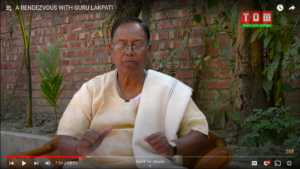
A rendezvous with Guru Lakpati
Akhu to Moushumi (12 May 2021)
After I read your email I spoke to my bandmate (Sunil) as his mother is one of the last exponents of Manoharsai…and Sunil also has interest in Sankirtan and been wanting to document his own mother,
Below is what he shared after i shared the mail with him:
‘I guess the Chinese style she is mentioning is our folk and penasaishak. Kirtan to my understanding has two main schools being practiced in Manipur: natsankirtan and monorshai. Monorshai style is very close to Indian classical compositions it has flair of ragas and talas whereas natsankirtan sounds like fusion of Manipuri Folk and bangaliKirtan styles but with unique percussion compositions of Meitei pung. There are my personal thoughts and my own analysis,you can ask my mom for details of monorshai and may be someone else for natsankirtan.”
I also spoke to his mother Sumati on phone, she said she can still sing in Bengali (Manoharsai) but she doesn’t [know] the meaning of it. She learnt it from a guru named Bagendra Sharma in Imphal. I have her phone number if you wish to speak to her.
Sunil has recorded her mother on some occasions. I believe he got those recordings still. He said he will share it soon with me as soon as his wife is healed from covid. Including my generation i can still read and write in Bengali. That’s what we learn growing up in school.
Yes our pronunciation would be very different and unique. I think Sunil has further plans to record his mother. I think we can trace thru these Gurus that from whom and where they learnt the songs and whose original composition are they..
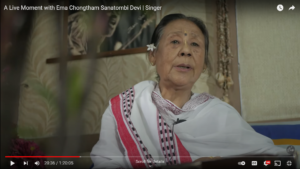
A Live Moment with Ema Chongtham Sanatombi Devi | Singer
Ema Chongtham Sanatombi Devi (b. 1938). If we take her story, for example, we see she started training in Nabadwip as a girl, having arrived there with her family as refugee from East Pakistan in 1947. Her guru Wangoi Chaobi Devi taught her kirtan such as Nimai Sanyas, Nouka Bilas, Man Bhanjan—the many episodes in the lives of Radha, Krishna and Sri Chaitanya Mahaprabhu.
Moushumi to Akhu (13 May 2021)
Firstly, can you please tell me more about how in this revivalist movement the politics of reclaiming, remembering and recreating has taken shape? What are the new forms and icons of the new identity? I think that with remembering is also attached the question of forgetting.
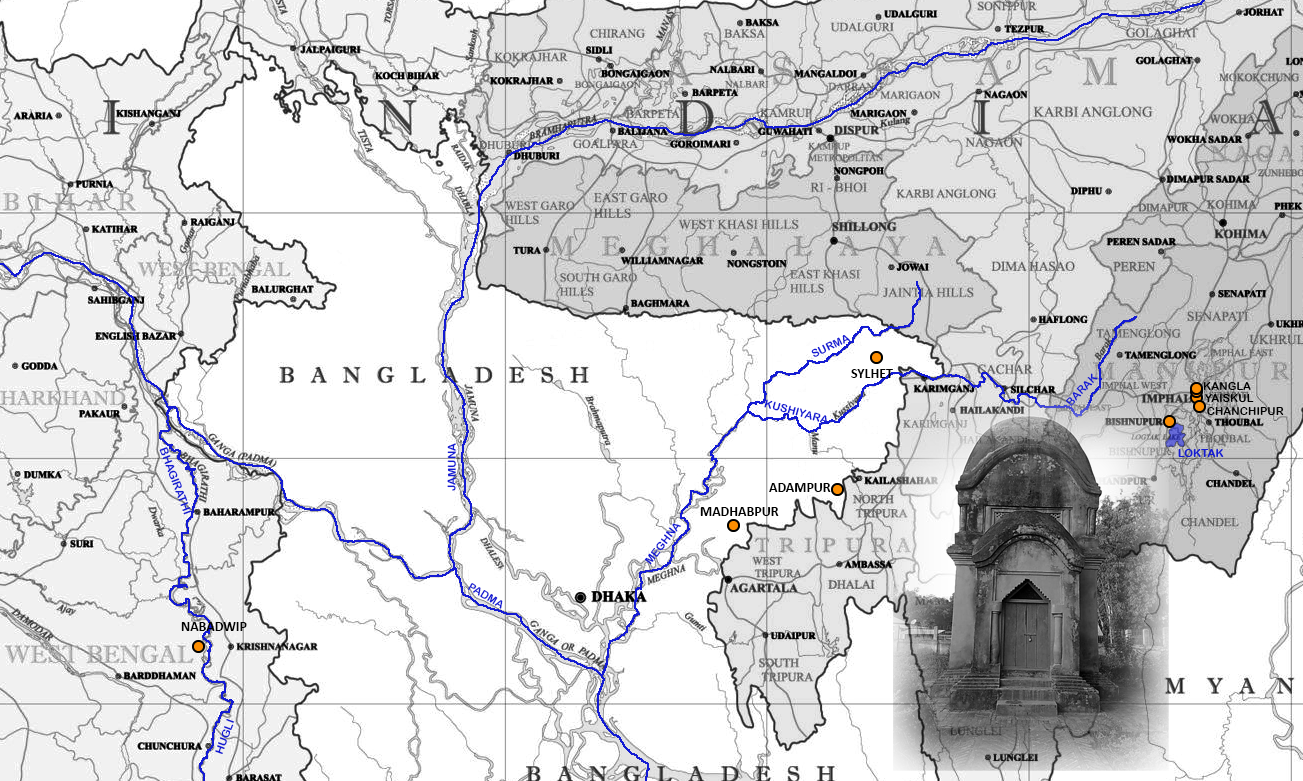
Map by Purba Rudra
Akhu to Moushumi (16 May 2021)
If you refer to the history of Manipur you will know how our own scriptures were burned down in the advent of Vaishavism in the 18th century.
18th and 19th century is even called ‘dark age’ in the history of our literature cos everything slowly replaced by Bengali. with the scripture, also our indigenous scripts called Meetei Mayek. What happened post the coming of Vaishnavism was a disaster culturally and traditionally. It totally changed everything. the society was divided. There were people who refused to follow the impositions of a foreign religion. These sections of the society are still present in today’s Manipur, in places like Kakching, Phayeng, Sekmai, Khurkhul, etc. (This is where i also do my annual festival “Where have all the flowers gone?”)
The revivalist movement that happened in early 20th century was started by this man named ” Naoriya Phulo”, He was from Cachar, Assam. He was successful in reviving our indigenous deity “Sanamahi”and then much later the most profound revivalist was Chingsubam Akaba, under his leadership the indigenous script “Meetei Mayek” was brought back forefront. Now it is taught in school and colleges officially. Akaba was shot dead in 2007 by some unknown persons.
There various other organisations that looks after our culture practices, they try their best to safeguard our culture and identity. But at times they can be quite annoying also as they are into moral policing. 🙂
Moushumi to Akhu (17 May 2021)
Everything cannot be erased, right? I mean, a language, yes, poets, yes. But what about the rhythms and melodies which have found a home in your land?
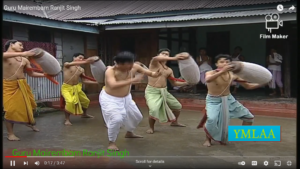
Akhu to Moushumi (16 May 2021)
Khol is very popular here. it is what is accompanied in Ras Leela. I used it once also in my recording.
It would be interesting to find out who actually went to Birbhum back then and from which school/gharana they learnt. I am sure the surviving gurus can shed some light on it.
Moushumi to Akhu (13 May 2021)
It would be so wonderful to trace what connections still remain despite the passage of time and changed political consciousness and context. I am always interested in listening to traces of the past in sound, because sound is ever layered and it carries so much history in its body. I think that even when they were singing Bengali texts in Manipur, the song was marked by the land and it would never have been a Bengali song. Similarly, today if the Bengali text is replaced by Meiteilon, or if the Bengali text is translated, then too the history that the Bengali text used to be sung once, that history will remain. It will remain inscribed in the new song too. This is what I mean by traces. We can try to dig into these songs, by removing layer after layer of knowledge, like an archaeologist. Treating sound as soil.
Akhu to Moushumi (16 May 2021)
Yes it will be very exciting to find traces of the past in these songs. We can study how it evolves in parallel to revivalist movements. I am sure All India Radio Imphal must be having old recordings of Sankirtan. it will be interesting to listen to these recordings.
Moushumi to Akhu (13 May 2021)
I know a Manipuri theatre director in Sylhet, Subhashis Sinha and it seems to me the reverse has happened there. There everything has got Bengalicised. Not many remain to sing the songs as they used to be sung fifty or 70 years ago. But the voice still carries traces, it still belongs to the past, and remains connected with other geographies. Those traces are carried in the style of singing. Something only a Manipuri will do, even if he or she has lived in a Bengali-majority land for half a century.
Bishnupriya Manipuri kirtan// jamthung, kamalpur
Akhu to Moushumi (16 May 2021)
Through my work with IFA, I worked for two years on the Manipuri Diaspora in Assam and Bangladesh. they have very interesting stories. Some of the music were made post the war in the mid 1970s, they were highly influenced by Rabindra Sangeet yet it is in Manipuri, so is the theme. These artists are still alive and they shared the stories how they started writing these songs out of compulsion as a minority in Sylhet. I am only grappling with these questions but would like to work on them. I do not have the depth of knowledge to deal with them. And I cannot do it alone. Will be great if we look into these things together.
Here is an article about my project on diaspora
The music album is available on youtube.
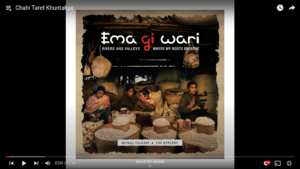
Moushumi to Akhu (2 June 2021)
Do you know about the theatre company Manipuri Theatre in Sylhet. The director is Subhashis Sinha. They are Bishnupuri Manipuris. I get confused as I don’t understand the subtle differences and do not know the history. His sister Sharmila is a beautiful singer. I did not know about her but have recently discovered her songs and I try to listen for traces of her ancestors’ voices in her voice. Sometimes she sounds like old Nazrul singers Firoza Begum or Suprabha Sarkar or Juthika Roy, and then she might be singing a Raslila song in Bangla, but from the way she uses her voice, I know that this could not come so naturally to a non-Manipuri. So, again, what we keep, what we have, what we might not be aware of–such thoughts come to my mind.
Subhasish sent me some kirtan recordings on youtube–clear Bengali diction, a very Nabadwip, Shantipur kind of Bangla, very Chaitanya-centric. But there are vocalisations here which I have heard in sankirtan.
Akhu to Moushumi (5 December 2021)
Today I recorded a sankirtan singer/performer named Thiyam Arun, who was a student of Lakpati. The recording was part of a museum of people’s music I am curating. I believe by the end of august [2021] i can share the audio. The artist could sing in bengali also. We did a bit of recording of it too.
The Manipuris in Bangladesh are three communities, Meetei, Meetei Pangal (Muslim) and Bishnupriyas. Meetei are the original Indigenous Manipuris in Bangladesh. Bishnupriya is a different ethnicity. I have been doing a bit of research on the Manipuri diaspora there. As the elders from Sylhet shared, there have been a lot of conflicts between the Meetei and Bishnupriyas. I am sure the Bishnupriyas must have their own practices and understanding of sankirtan. And it will be interesting to find out. Among the Meetei community in Sylhet also there are sankirtan singers.
As I said earlier, I am not an expert on sankirtan, I don’t think i am fit to write at length about sankirtan.
Moushumi’s correspondence with Shuvashis and Sharmila Sinha, Bishnupuri Manipuri artistes from Komolganj, Moulavibazar, Sylhet.
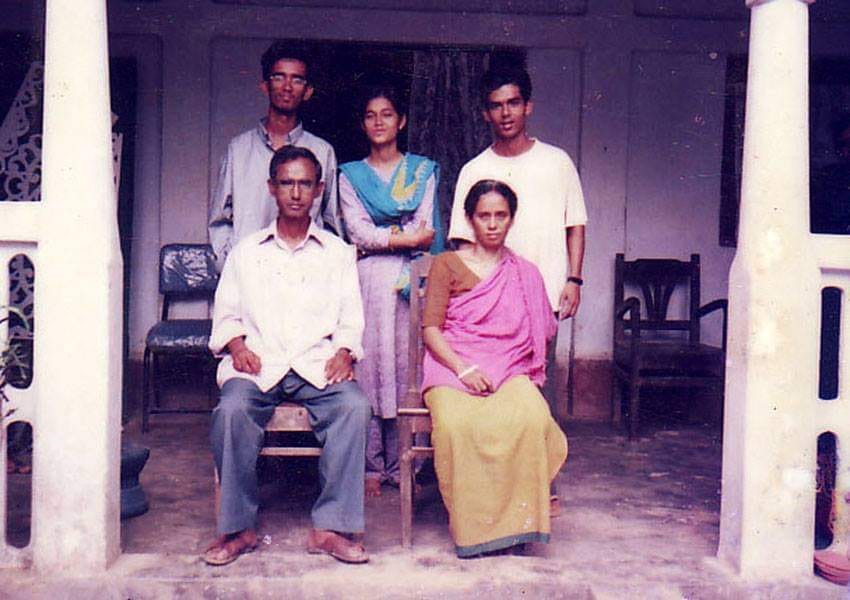
The Sinha siblings, from left to right, Shuvashis, Sharmila and Debashis with their parents in Kamalganj, Moulavi Bazar, Sylhet, Bangladesh. Shuvashis is a theatre director and runs Manipuri Theatre, a company which turned 25 this year. Sharmila is a singer and music director of their theatre company. Debashis is a paediatrician. Their father was a school teacher and mother too is a cultural activist.
[The following text is in Bangla, but there are interesting videos, so do scroll down and there will also be a description in English.]
কথা শুরু হয় শুভাশিসের সঙ্গে।
শুভাশিসকে মৌসুমী (12 May 2021)
প্রিয় শুভাশিস, তুমি বলেই লিখছি, আপনি লিখতে একটু অশ্বস্তি হচ্ছে। অম্বরীষদা’র কাছে তোমার অনেক গল্প শুনেছি। তুমিও আমার কথা শুনে থাকবে, হয়ত গানও। আমি আসলে যাঁকে নিয়ে গবেষণা করছি অনেক বছর ধরে, তাঁর নাম আর্নল্ড বাকে, তিনি হল্যান্ডের মানুষ ছিলেন। ভারতে এসেছিলেন ১৯২৫-এ, শান্তিনিকেতনে, প্রথম পর্বে ডক্টরাল স্টুডেন্ট হয়ে ছিলেন ২৯ পর্যন্ত, সেই সময় বাংলায় এবং ভারতের অন্যান্য অঞ্চলের গান ওঁকে আকৃষ্ট করে, মূলত রবীন্দ্রনাথের গান, আর বাউল কীর্তন, নানা কিছু। ৩১ সালে আবার ফিরে আসেন একটি মোমের সিলিন্ডারে রেকর্ড করার যন্ত্র নিয়ে, এবং আমাদের বঙ্গদেশে ঘুরে ঘুরে অনেক ফিল্ড রেকর্ডিং করেন, ১৯৩৪ পর্যন্ত, অন্য জায়গায়ও করেন, যেমন নেপালে। আমি বাকে সাহেবের বেঙ্গল রেকর্ডিং নিয়ে কাজ করছি। আমি ওঁর এক একটা রেকর্ডিং ধরে সেই মানুষ আর স্থান আর ইতিহাসের সন্ধানে ঘুরে বেরিয়েছি অনেক দিন ধরে। শ্রবণ দিয়ে কীভাবে আমরা ইতিহাস রচনা করতে পারি, সেটা আমার কাজের একটা দিক, আর আর্কাইভ কীভাবে তোইরি হয়, সেটা কাজের অন্য দিক। আর্নল্ড বাকেকে কীর্তন খুব টেনেছিল, গুরুদের কাছে কীর্তন গাইতে শিখেছিলেন, ওঁর তৃতীয় দফায় ভারতে আসা (৩৮-৪৫) এবং থাকার শেষ পর্বে এমনকি বৃন্দাবনে গিয়ে কীর্তন গেয়েওছিলেন। ১৯৩৩-এ বাকে ময়নাডাল বলে বীরভূমের একটি কীর্তনের পীঠস্থানে গিয়ে ওঁদের গান আর তাল রেকর্ড করেছিলেন, ময়নাডালে কীর্তনের টোল ছিল, সেখানে ছাত্ররা আসতেন বিশেষ করে খোল বা মৃদঙ্গ শিখতে। মণিপুর থেকেও ছাত্ররা আসতেন। ১৯৫৬ সালে বাকে সাহেব শেষবার ভারতে আসেন। তখন তিনি লন্ডনের SOAS-এ ভারতীয় সঙ্গীত এবং সংস্কৃত পড়ান। সেটা ওঁর স্টাডি লীভ ছিল। ইচ্ছে ছিল মণিপুরে যাবেন, কীর্তনের সন্ধানে। যাওয়া হয়নি। আমি আজ যখন বাকে কে নিয়ে কাজ করছি, তখন দেখার চেষ্টা করছি, আজ বাকে’র রেকর্দিং থেকে আমি কেমনতর শ্রবণের কাছে পৌঁছতে পারি। মণিপুরে বাকে যেতে পারেননি। কিন্তু যেতেন যদি কেমন কীর্তন শুনতেন। আজ সেই কীর্তন কোথায় দাঁড়িয়ে আছে? আমি পড়ছিলাম ৬৩ সালের একটি লেখায়, একজন মেইতেই স্কলারের লেখা, যে তখন যে টেক্সট গাওয়া হতো তা বাংলায় ছিল। অথচ মনীপুরের নিজস্ব গায়নে, উচ্চারনে সেই গান মনিপুরি কীর্তনই হয়ে যেতো, এক আশচর্য সংমিশ্রন ছিল অতএব সেই সংকীর্তনে। আজ তোমাদের দিকে সব গান শুধু বাংলাতেই হয়। মণিপুরের নিজস্ব ভাষায় হয় না। ওদিকে মণিপুরে আমার পরিচিত শিল্পী এবং স্কলারদের বক্তব্য হলো, ওখানকার পুনর্জাগরণ (revival) অন্দোলনের ফলে বাংলা সম্পূর্ণ মুছে দিয়ে শুধু মেইতেই ভাষাতেই ওঁরা এখন সংকীর্তন করেন। জাস্টিস আসলে ওইভাবে হয় না, পুরনো আধিপত্যকে আমরা কেবল নতুন আধিপত্য দিয়ে replace করি। আমার সেইরকমই মনে হচ্ছিল।
তোমরা যেহেতু এহেন চর্চার ভিতরে আছ, তোমাদের ওখানে কেমন কীর্তন হতো আর আজ কেমন হয়, সেই বিষয়ে আমাকে বলতে পারো। পুরনো রেকর্দিং থাকলে আমায় দিতে পারো? আজ কেউ যদি গান, তোমার আশপাশের কেউ, তাঁর গানের কিছু নমুনা রেকর্ড করে আমায় পাঠাতে পারো। তোমাদের ওখানে মণিপুরী মুছে যাচ্ছে, এদিকে বাংলা।
আমার এই ভাবনার সম্পর্কে তোমার কী মনে হয়? জানিও। তোমার চিঠির অপেক্ষায় থাকবো।
মৌসুমীকে শুভাশিস (14 May 2021)
দিদি, আমাদের এখানে যে কীর্তন গাওয়া হয় তা হরিনাম সংকীর্তন বা পদাবলী কীর্তন থেকে বেশ ভিন্নএখানে এই পরিবেশনা নটপালা নামে অভিহিতনটসংকীর্তনও বলা হতো এক সময়এটি গায়ন অভিনয় নৃত্যভঙ্গি বাদ্য ইত্যাদি নানান শিল্পরূপের এক ধরণের নাট্যিক প্রকাশ, যদিও গীত বা পদগীত তার মূল ভিতকিছু নমুনা পাঠাতে পারবএর পদগুলো বাঙালি বৈষ্ণব পদকর্তাদের রচনা থেকে গৃহীত হলেও গায়কীতে মণিপুরি সুর ও স্বর প্রক্ষেপণের সংশ্লেষ আছেআমিও এ নিয়ে বেশ অভিজ্ঞ নয়, আমি ইমপালসটা বুঝি,,অনুভব করি, আমাদের এখানেও অনেকেই মণিপুরি ভাষায় পালা গাওয়ার চেষ্টা করেন, পদ বাঁধেন, কিন্তু বাংলা ভাষার পদই বেশির ভাগ গী’ত হয় কখনো বা ব্রজবুলি…আরো কথা হবে
মৌসুমীকে শুভাশিস (2 June 2021)
দিদি, লকডাউনে সব বন্ধএখন তাদের সাথে বসা যাচ্ছে নাতাই কিছু লিংক দেব। পরিবেশ পরিস্থিতি অনুকূল হলেকয়েকটি পালার গান মোবাইলে ধারণ করে দেব।
ইনি বাংলাদেশের
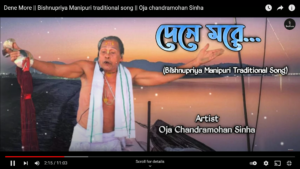
Dene More || Bishnupriya Manipuri traditional song || Oja chandramohan Sinha
এঁরা ত্রিপুরার
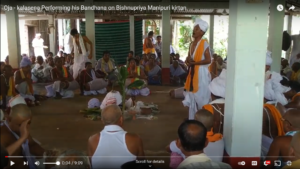
Oja – kalasena Performing his Bandhana on Bishnupriya Manipuri kirtan
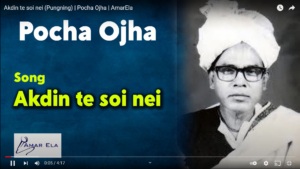
Akdin te soi nei (Pungning) | Pocha Ojha | AmarEla
শুভাশিসকে মৌসুমী (2 June 2021)
এই মেইতেই আর বিষ্ণুপ্রিয়া বিষয়ে কোনো লেখা থাকলে আমাকে বোলো। আমি বীরেন্দ্র সিংহ’র গানটা শুনছিলাম, উচ্চারণ এত বেশি পশ্চিমবঙ্গীয়।মানে, সিলেটের ভাবও নেই।
মৌসুমীকে শুভাশিস (2 June 2021)
সিলেটের ভাব থাকে না, মণিপুরি গায়নভঙ্গি ।
শুভাশিসকে মৌসুমী (2 June 2021)
সেটা কী করে হলো? অর্থাৎ, যে পরম্পরায় শিক্ষা, সেই পরম্পরা পশ্চিমবঙ্গের
উচ্চারণের কথা বলছি
মৌসুমীকে শুভাশিস (2 June 2021)
নদীয়া, নবদ্বীপ, পশ্চিমবঙ্গ সেখানকার পদকর্তাই বেশিতাদের রচনার যে ভাষিক প্রকাশ, তার অনুসরণ করা হয় বোধহয়। আমি একজন বড় পালাকারের নাম্বার দেব, আলাপ করে নেবেন একটু, দিদি
শুভাশিসকে মৌসুমী (2 June 2021)
ধরো, তোমার দিদির যে গান, তাতে কিন্তু অঞ্চলও ধরা আছে, এক ফাঁকে আঞ্চলিক উচ্চারণ শুনতে পাওয়া যাবে। এখানে সেটা হচ্ছে না কেন, আমি ভাবছি
মৌসুমীকে শুভাশিস (2 June 2021)
ভাষাটাকে শুদ্ধভাবে ধরাটাও তাদের আকাঙ্ক্ষায় থাকে হয়তো বা
সেটাও এক অর্থে রিচুয়াল
ডিকশনাল রিচুয়াল।
শুভাশিসকে মৌসুমী (2 June 2021)
আমিও তেমনই ভাবছিলাম। এটাই শিক্ষার রীতি।
পারফেক্ট, এই ডিকশনাল রিচুয়াল কথাটা।
ইম্পাল টকিজ ব্যান্ডের আখু চিঙ্গাম্বামকে চেনো? ও তোমাদের ওদিকে গিয়েও কাজ করেছিল। ওদের ওদিকে বাংলা টেক্সট ওরা বর্জন করে একটা নিজের ভাষা আর আইডেন্টিটি রিক্লেইম করার প্রক্রিয়ার ভিতর দিয়ে গেছে, যাচ্ছে, বলছিল। যাঁরা বাংলা গান গাইতেন, তাঁরাও বাংলা না জেনে স্রেফ গানগুলো শিখেই গাইতেন। ওদিকে তোমাদের ওদিকে বাংলার আধিপত্যে তোমাদের নিজেদের ভাষা শুধু না গানের ভাবেরও হয়ত বাঙালিকরণ হয়েছে। এই আইডেন্টিটি পলিটিক্স নিয়ে ভাবছিলাম এই কীর্তনের কন্টেক্সট-এ। তাহলে এই শিল্পীরা কোথায় মণিপুরী। আর ওখানকার শিল্পীরা কোথায় বাঙালি, এখনো? কারণ সবটা তো মুছে যায় না।
আখু একজনের গান আমায় শুনতে দিলো, কীর্তন না। সিলেটের মণিপুরী। ধরো, এতে তো লতা মঙ্গেশকরের লগ যা গলে, আর মৌবনে আর মৌ জমেছে আর কত কত সুর মিশে আছে। থাকারই কথা।
মৌসুমীকে শুভাশিস (2 June 2021)
হ্যাঁ দিদি, খুবই প্যারাডক্সিক্যাল ব্যাপার।
কথা শুরু হয় শুভাশিসের সঙ্গে, ওর দিদি শর্মিলা কথোপকথনে জড়িয়ে যায়। অগাস্ট ২০২১ থেকে ব্যাপারটা এমন দাঁড়ায় যে,শর্মিলা আর আমি গল্প করি রাত ধরে।
শর্মিলাকে মৌসুমী (10 August 2021)
আমি একভাবে ভাবার চেষ্টা করেছি, যদি ১৯৫৬ তে বাকে সাহেব মণিপুরে যেতেন, কী শুনতে পেতেন? মণিপুরে ইতিমধ্যে revivalist আন্দোলন শুরু হয়ে গেছে, প্রাক-বৈষ্ণব ইতিহাসের দিকে ওরা ফিরে যেতে শুরু করেছে, বাংলা,বাঙালি, বৈষ্ণব সংস্কৃতিকে ঔপনিবেশিক আগ্রাসন বলে চিহ্নিত করতে শুরু করেছে, যেমন করে ওদের প্রাচীন লিপি, পুঁথিকে বিলুপ্ত করা হয়েছিল, তেমন করে বাংলাকে মুছে দেবার চেষ্টা শুরু হয়ে গেছে। আমি আমার কাজে ইতিহাসের অস্পষ্ট রেখা, হারিয়ে যাওয়া, মুছে দেওয়া রেখা যে সম্পূর্ণ মুছে যায় না, তাকেই দেখার চেষ্টা করেছি। যেমন তোমরা একটা সম্পূর্ণ বাংলা সংস্কৃতির ভিতরে থাকো, কিন্তু তবু তোমার কন্ঠে, তোমার গায়নে মণিপুর রাখা আছে। কীভাবে থাকলো? কীভাবে মণিপুরের হারিয়ে যাওয়া সংস্কৃতির দিকে ফিরে যেতে শুরু করলো মণিপুরের মানুষ? কিছু সূত্র ছিল বলেই তো পারলো? আবার, আজ যে বাংলাকে মুছে দিচ্ছে, সবটা কি মুছে যাচ্ছ? যেতে পারে কি? আমি গানের ভিতর এই অস্পষ্ট রেখাগুলোকে শোনার চেষ্টা করতে চাই। এ-ই হলো ব্যাকগ্রাউন্ড। ফলে ধরো একটু বয়স্ক যাঁরা (তোমার গুরুর ওপর প্রিয়াঙ্কা চৌধুরীর লেখাটা পড়লাম) তাঁদের সঙ্গে একটু কথা বললে,তাঁরা গাইলে, এই দ্বান্দ্বিকতাটা হয়তো একভাবে ধরা যাবে।
একেও এক মৌখিক সংস্কৃতি বলা চলে। শুনতে আসলে পাওয়া যায়, আমি তোমার গলায় শুনতে পাই এমন কিছু যা তোমার অতীত থেকে আসা। এই সব কথা কি আর ক্ষুদ্র বাক্সে [Messenger-এ মেসেজ চালাচালি হচ্ছিল] লিখে বলা যায়? এতো গেয়ে গেয়ে, কথায় গল্পে বুঝতে বুঝতে চলি আমরা। তবু তুমি দেখো, যেমন করে তোমার ভাবনা এগোয় , আমায় জানিও। তোমার গুরুর কথা, গান এমনিতেও রেকর্ড করে আমার আর্কাইভে রাখলে ভালই হবে, তাই না? কথা বলবে যখন তখন একটু ভিডিও ও কোরো। আর মায়ের সঙ্গেও তো বসে কথা বলে রেকর্ড করতে পারো, তাই না?
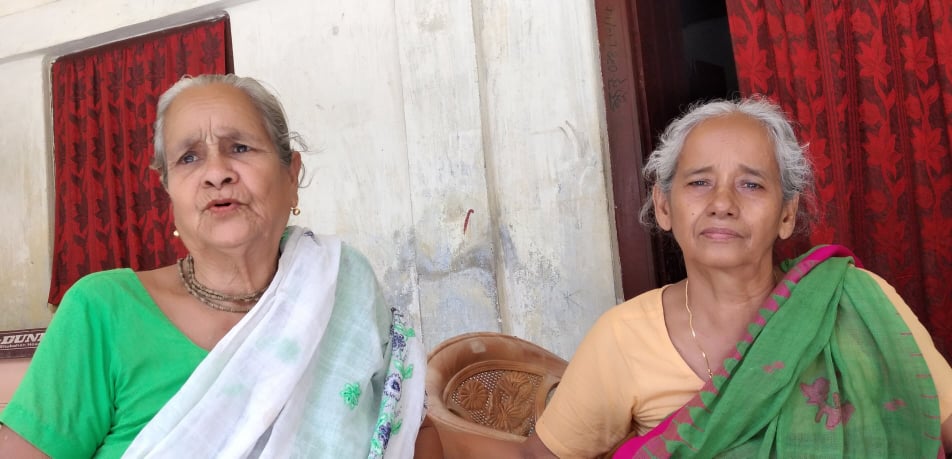
Sharmila’s mother Fazatambi Sinha and guru Krishnakumari Sinha.
মৌসুমীকে শর্মিলা (28 November 2021)
মৌলভীবাজার জেলার কমলগঞ্জ উপজেলায় মূলত মণিপুরিরা থাকি বিভিন্ন গ্রামে।আমাদের গ্রাম ঘোড়ামারা, জ্যোতিরও [actor, dancer Jyoti Sinha],ও আমার কাকাতো বোন।আমার গুরু থাকেন পাশের আরেকটা গ্রামে ‘মাধবপুর’ নাম। সেখানেই পাশাপাশি তিনটা মণ্ডপে আমরা ‘জোড়ামণ্ডপ’ বলি, সেখানে কার্তিক মাসে পূর্ণিমা তিথিতে মহারাসলীলা অনুষ্ঠিত হয় তিনটি মণ্ডপে তিনটা একযোগে, লাখ লাখ মানুষের সমাগম হয় সেদিন। দুপুর থেকে শুরু হয় গোষ্ঠলীলা, মেলা থাকে দু’দিনব্যাপী, মেলায় আমরা বইয়ের স্টল দেই রাত ১০/১১ টা পর্যন্ত, তারপর রাস ১১ থেকে শুরু হয় ভোর পর্যন্ত চলে।
আমি গুরুর সাথে কথা বলবো এ বিষয়ে, রেকর্ড করে রাখব আলাপচারিতা, তারপর পাঠাবো আপনাকে, কিন্তু একটু সময়সাপেক্ষ হবে হয়তো। এ ছাড়াও এ সম্পর্কিত তথ্যাবলী জানতে চেয়ে একজন গবেষকের কাছে মেসেজ করেছি, তিনিও বলেছেন দেখছেন তবে সবকিছুই একটু সময় সাপেক্ষ। আশা করি, কয়েকদিনের মধ্যে কিছু তথ্য আপনাকে জানাতে পারবো, দিদি।
গুরুর সঙ্গে কথাবার্তা। Conversations with her guru.
শর্মিলা বুঝিয়ে দেন এই কথোপকথনের অর্থ। Sharmila explains the content of this [telephonic] conversation.
গুরু শিষ্যের আলাপচারিতা, ভালোমন্দ জিজ্ঞাসাবাদ আর মাসী (গুরুর) কণ্ঠে রাসলীলার দু’একটি অঙ্গের কিছু গান।গানগুলি বাংলায় আর কথাবার্তা মণিপুরি ভাষায়।বিষ্ণুপ্রিয়া মণিপুরিদের ভাষা অসমীয়া-বাংলার মিশেলে গঠিত। সিলেটি শব্দও ঢুকেছে অনেক।এমনিতে কুশল জিজ্ঞেস করলাম গুরুর।
A conversation between guru and shishya, master and disciple. We start with a cordial exchange of greetings and everyday news. Then Masi (guru) sings some extracts from Ras Lila. The songs are in Bangla but the conversation is in Manipuri, with some Sylheti words thrown in for flavour.
তারপর গানের ব্যপারে জিজ্ঞেস করলাম যে, মাসীদের গলায় সুরের যে কারুকাজটা থাকে সেটা আমাদের গলায় থাকে না কেন, মাসী কার কাছে গান শিখেছিল ইত্যাদি ইত্যাদি।উত্তরে মাসী বললেন এটা তাঁর/তাঁদের সাধনার ফল। তিনি আমাকে আগে একবার দেখিয়েছিলেন গলায় থুতনির ঠিক নীচটাতে একটা জায়গা কাঁপিয়ে গলায় কারুকাজটা কীভাবে আনেন, সেটাকে তিনি বলেন ‘কালাবাতি’, সম্ভবত ‘কালোয়াতি’ হবে।সেটার উল্লেখ করলেন, তাঁর গুরুরা মণিপুর থেকে শিক্ষা নিয়ে এসেছিলেন, একজন সেনা সিংহ অন্যজন কামিনীমোহন সিংহ। তাঁদের কাছে নিরন্তর শিক্ষা গ্রহণ করেছেন, সাধনা করেছেন, অনেকগুলো রাসে সূত্রধারী করেছেন। আর আমাদের গলা একটা নির্দিষ্ট ছাঁচে ঢালা গান গেয়ে অভ্যস্ত হওয়ায় গলায় উঁচু নীচু এই মণিপুরি সুর বসতে সময় লাগছে, তবে তিনি আশাবাদী, একদিন হবে।
Then we talked about vocal technique. The embellishments which come to them so naturally, the classical style, ‘kalowati’ or virtuosity, which we find hard. She showed me how to do it, where the vibration under the chin should be. She told me how she had learned these things from her gurus, Sena Sinha and Kaminimohan Sinha. They had gone to Manipur for training.
আরও বললেন যে, এখন রাসলীলা গান কিছু কিছু মণিপুরি ভাষায় অনূদিত হচ্ছে, এটা বিভিন্ন স্টেজ প্রোগ্রাম বা বেতারে প্রোগ্রমের প্রয়োজনে গেয়েছেন কিন্তু রাসলীলায় বাংলা বলন্তা মানে পদকর্তাদের রচিত গানগুলোর যে ভাব, রস তা সেইমতো বজায় থাকে না বলে তাঁর বাংলাতেই এই ভাবরসের গানগুলো গাইতে ভালো লাগে এবং তিনি তাই করেন। সেইমতো গান রচিত হলে বা অনুবাদিত হলে সেটা অন্য কথা।
Then she said that now some Raslila and Natapala songs are being written in Manipuri, for the radio and stage. However, the ‘rasa’ or juices which the age-old Bangla poetry holds, is lost in the Manipuri. So, she prefers to sing in Bangla.
তারপর রাসে যুগলরূপবর্ণনার একটা গান ‘ভুবনমোহন রূপ’ গাইলেন। অভিসার অঙ্গের কিছু টুকটাক গানও করলেন। সেটা বাংলায় হওয়ায় নিশ্চয় বুঝতে পেরেছেন, দিদি।
She then sang a song describing the beauty of Radha and Krishna in union, jugalroop, ‘Bhubanomohonoroop’. She also sang some lines from the Abhisar chapter of the Radha-Krishna story in which Sri Radhika has set out on her own, in secret. to meet Sri Krishna.
মৌসুমীকে শর্মিলা (10 August 2021)
Sharmila gives a historical context for the Manipuri people’s adoption of Vaishnavism; to escape the repression of the Burmese rulers, she says. This is a different reading of history from Akhu’s.
দিদি, আমাদের প্রজন্মের শিল্পীদের গলায় সেই অরিজিনালিটি এখন আর তেমন নেই যেটা এখনও আমাদের মা বা মাসী (গুরু) র গলায় আছে।এটা হয়তো বিবর্তন বা অভিবাসনের প্রভাব। আমাদের পূর্বপুরুষেরা প্রায় ২০০ বছর পূর্বে মণিপুর থেকে বিতাড়িত হয়ে কিছু অংশ আসাম, ত্রিপুরায় আর কিছু অংশ বাংলাদেশে অভিবাসিত হয়েছেন।ধারণা করা হয়, পাহাড় ছেড়ে যখন সমতলে এসে বসতি স্থাপন শুরু হয় তখনই গলার মধ্যে মণিপুরের সেই Authentic সুরও আস্তে আস্তে বিবর্তিত হয়ে গেছে।যদিও এখন হিন্দুস্থানী ক্লাসিক্যালের সাথে রবীন্দ্রনাথ, নজরুল, অতুলপ্রসাদ, রজনীকান্ত, ডি. এল রায়, হিমাংশু দত্ত, এস. ডি বর্মণ ইত্যাদি ছাড়াও বাংলার বাউল, ফোক, কীর্তন, জারি, সারি, ভাওয়াইয়া, ভাটিয়ালী ইত্যাদির মিশ্রণের মাধ্যমে মণিপুরি সুরের অরিজিনালিটি অনেকাংশে চলে গেলেও পরম্পরাগতভাবে বা জিনগতভাবে কিছুটা হয়তো রয়ে গেছে।আর আপনি যদি কোনোদিন আমাদের এদিকে আসেন তবে দেখবেন, মণিপুরি জাতিগোষ্ঠীর মধ্যেপ্রায় সবারই গলায় সুর আছে এবং আমাদের পূর্ববর্তী প্রজন্মদের শিল্পীদের গলায় সুরটা এখনও মোটামুটি বজায় আছে।আমরা সংকরায়িত হয়ে গেছি অনেকখানি। কারণ আমরা বাংলা ভাষায় পড়াশুনো করেছি স্কুল, কলেজে। আমাদের সাংস্কৃতিক পরিবেশ, প্রতিবেশ বাংলা পরিবেষ্টিত। আমরা ছোটবেলা থেকে বাংলা গান শিখেছি, বড় হওয়ার পর নিজের সংস্কৃতি নিয়ে সচেতন হওয়ার পর আমরা ফিরে তাকাতে শুরু করেছি।তাই আজ আমার গানের গলার সাথে একজন বাঙালির গলার তেমন কোনও তফাৎ নেই, গভীর মনোযোগ সহকারে শুনলে হয়তো কিছুটা ফারাক বোঝা যাবে।
বর্মিদের অত্যাচার থেকে আত্মরক্ষার উপায় হিসেবে মণিপুরিরা, বিশেষত বিষ্ণুপ্রিয়া মণিপুরিরা বৈষ্ণব ধর্মের অনুসারী হন এবং সেই সময়ে বৈষ্ণব পদকর্তাদের রচিত পদ আর সুরকে আত্মীকরণ করে এবং নিজের সুরের সাথে মিলিয়ে স্বাতন্ত্র্য বজায় রেখে একটা মৌলিক শিল্প তৈরি করেন।তদ্বকালীন মহারাজাদের পৃষ্ঠপোষকতায় এসব গড়ে ওঠে। যেমন, মহারাজ ভাগ্যচন্দ্র স্বপ্নাদিষ্ট হয়ে তাঁর রাজসভায় প্রথম নিজ কন্যাকে দিয়ে রাসলীলার আয়োজন করেন।
এসব আমার জ্ঞানলব্ধ।এর পরের বিষয়াবলী সম্পর্কে আমি অবগত নই তেমন, আমি আমার একজন মেসতুতো দাদার লেখা কিছু টপিক আপনাকে শেয়ার করবো পরবর্তীতে, তিনি এ সংক্রান্ত পড়াশুনো করেন বিশদ।
আর এ কয়েকদিন লকডাউনের কারণে মাসী (গুরু)র সাথে দেখা হচ্ছে না, আমি ফোনে কথা বলি তাঁর সাথে। কাল পরশু এ ব্যাপারে তাঁকে জিজ্ঞেস করব, তবে তিনি এ সব বিষয়ে কিছু বলতে পারবেন বলে মনে হয় না।আমাদের মণিপুরি গুরুরা তাঁদের পূর্ববর্তী গুরুদের থেকে রাসলীলা বা নটসংকীর্তন পালার লিখিত পদগুলি দেখে গুরু শিষ্য পরম্পরায় শিক্ষালাভ করেন। এগুলো তো বিশাল গবেষণার বিষয়।
শর্মিলাকে মৌসুমী (22 August 2021)
আমি তোমার এই লেখা আর ব্যাখ্যা কপি করে রাখছি। এই যে কথাটা যে দু’টো ভাষার মধ্যে চলাচল করে চলেছেন আর কিন্তু রাখা রয়েছে জন্মজন্মান্তর থেকে আর কিছু নতুন জমিতে নতুন ফসল ফলেছে–এইসব কথাই আমাকে নাড়া দেয়। তোমার গানও যদি পাঠাও, পাশাপাশি রাখতে পারি। এসব আমার ওয়েবসাইটের জন্য, দেখেছো হয়তো।
Sharmila sings a song from Raslila.
She writes about the song: মণিপুরি রাসলীলার একটি গান.. একটি ভীরু প্রয়াস…আমার মণিপুরি সঙ্গীতগুরু অজা কৃষ্ণকুমারী সিনহার প্রতি শ্রদ্ধা…’এই হেন নিশীথকালে’ অজাদের মুখে মুখে ফিরতে ফিরতে ‘ই হেন’ হয়েছে, আমিও সেইমতো গাইলাম।রাসে কৃষ্ণের রূপ বর্ণন অংশের শুরুটা এই গান দিয়ে হয়।
শর্মিলাকে মৌসুমী (25 October 2021)
এটা যে পাঠিয়েছ, এ তো অসম্ভব সুন্দর। আর, এটাই আমি বুঝতে চাইছিলাম। এউ যে বাংলায় গাইছ, কিন্তু কাকে গানের ভাষা বলবো? এ তো কেবল বাংলা গান না। এই স্বর প্রক্ষেপণ, এই সুর, এই কন্ঠস্বর, এই ভূগোল—এসব কোনো একটা ভাষা দিয়ে ধরা যাবেই না।
মৌসুমীকে শর্মিলা (25 October 2021)
একদম। ভাষা আর সুর বহু বছর ধরে এমন মিলেমিশে গেছে যে বাংলা পদকর্তাদের রচিত এইসব গান আজ মণিপুরি রাসলীলার গান হয়ে গেছে।
আর, এটা ২০১৯-এর জন্মাষ্টমীতে গাওয়া গান। ‘উঠিতে কিশোরী, বসিতে কিশোরী
কিশোরী নয়নতারা…’। মধ্যযুগের কবি বড়ু চণ্ডীদাস রচিত ‘শ্রীকৃষ্ণকীর্তন’ কাব্যগ্রন্থ থেকে নির্মিত আমাদের থিয়েটারের সোয়াএকঘন্টার প্রযোজনা ‘শ্রীকৃষ্ণকীর্তন’ এর একটা ছোট্ট অংশ।
এগুলি হলো মানত করা এক রাসলীলার রিহার্সেলের অংশ বিশেষ।
শর্মিলাকে মৌসুমী (28 November 2021)
আচ্ছা, একটা অন্য কথা জিজ্ঞেস করি। সাম্প্রদায়িক দাঙ্গা হয় যখন, নিদেনপক্ষে টেনশন সৃষ্টি হয়, তখন তোমাদের ওপর তার কোনো প্রভাব পড়ে? Are there communal tensions between the Vaishnava Manipuris and Bengali Muslims when there is tension between Hindu and Muslim in the country? Moushumi asks Sharmila.
মৌসুমীকে শর্মিলা (28 November 2021)
Actually, we live in peace and harmony here, Sharmila says.
সত্যি বলতে দিদি, আমরা চারপাশে মুসলিম পরিবেষ্টিত থাকি যদিও কিন্তু আমাদের সাথে ওদের সম্পর্কটা সৌহার্দপূর্ণ। এখানটা বেশ জনবৈচিত্র্যপূর্ণ। এখানে মুসলিম মণিপুরি, আমরা বৈষ্ণবানুসারী, বাঙালী, চা-জনগোষ্ঠী, শব্দকর, খাসিয়া ছাড়াও আরও ক্ষুদ্র জনগোষ্ঠীর সহাবস্থান আছে, মিলেমিশেই থাকি। আমাদের রাসে মুসলিম দর্শকদের আধিক্য দেখা যায় আর মেলায় তো সারা দেশ থেকে বিভিন্ন জিনিসের পশরা নিয়ে মুসলিমরাই আসেন।কোনোদিনই তেমন কোনও অঘটন ঘটে নি, তবে এবারের দুর্গাপূজোয় চা-শ্রমিকদের দু’একটা মন্দিরে ভাংচুর হয়েছে। এটা রাজনৈতিক স্বার্থেই হয়েছে বলে ধারণা করি, সাধারণ মানুষদের মধ্যে আসলে সাম্প্রদায়িকতার বীজটা এখনও গভীরে প্রোথিত হয় নি।
Related reading
শুভাশিস সিনহা, মণিপুরী সংস্কৃতির অন্তর্গত লড়াই ও রাসলীলা, পথিক, সাহিত্যের ছোট কাগজ,৯ নভেম্বর ২০১০।
- Manoharsai from Sumati Devi of Manipur
- In Search of Nabadwip Brojobashi
- Nirmalendu Mitra Thakur Explains Bake’s Kirtan Recordings, 2021
- Found Film: Janmashtami and Nandotsav in Mainadal, 1994
- Kirtaniya Seema Acharya Listens to Olly
- Olly Weeks Reads Bake’s Kirtan Notation
- In Mongoldihi, November 2015
- The Niyomsheba Songs, October 2014
- First Time in Mainadal, August 2014

